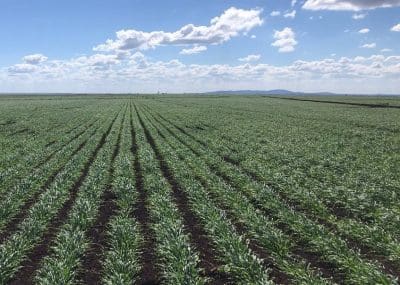FEEDLOTS looking to price new-crop wheat are starting to base their buying ideas around the value of wheat to be harvested in Central Queensland (CQ) from September onward.
CQ crops were planted on time and into good moisture, and most have benefitted from timely follow-up rains.
It makes CQ the most likely district north of southern New South Wales to achieve average or better yields across the board, and this has allowed growers and traders to forward sell some tonnage.
Cheaper CQ wheat at harvest might break the hold old crop prices have over consumers on the Darling Downs in southern Queensland who are presently paying $420-$430 per tonne for nearby delivery as the end of the current crop year approaches and new-crop prices for January forward clarify.
“I can see the Sep-Oct Downs market getting down to $390-$400/t, based on the cost of new-crop execution,” one trade source said of the CQ supply.
January 2020 delivered Downs wheat was quoted in the $380-385/t range based on WA, but business could execute with wheat trucked north from Victoria or southern NSW.
Mixed prospects
Large tracts of central and northern NSW and the Downs remain fallowed in readiness for a winter-cereal crop, which now looks increasingly unlikely to get planted.
While some farmers in those districts have wheat and barley crops in the ground and looking good, Norco trader Simon McDougall said yield prospects were uncertain without a soaking rain in coming weeks.
“Most crops only have 30-60 centimetres of moisture below them, and on the Liverpool Plains, crops need 150 millimetres of rain to get them home,” Mr McDougall said.
“You wouldn’t want to have gotten to the middle of August and not had it.
“The two-week forecast is showing no rain, and that means it’s likely some crops will get grazed or baled, so thank goodness for CQ, and for WA and a positive Indian Ocean Dipole.”
Yield prospects in much of South Australia, Victoria and southern NSW are also promising, provided crops get timely rains in coming months.
Trade sources think consumer demand in southeastern Australia may make that grain too expensive to price into northern NSW and Queensland markets anywhere outside metropolitan Brisbane and adjacent zones.
“Early in 2017-18, we were buying grain out of Victoria and taking it north of Dubbo.
“That market isn’t working yet.
“For white grain, we look like we are going to be executing out of the port to January 2021.”
In a repeat of last year, trade sources have said crops harvested in central and northern NSW and southern Queensland will have little impact on the new-crop cash market.
“People will fill up their silos, or sell it to a domestic end-user close by.”
In southern NSW, the Riverina market for current crop has been trading in a range-bound $395-$400/t delivered.
“The market tries to pull lower, but that range we’re in seems to be working for the long holder and the willing seller,” one trader said.
“The buyers are picking off the troughs, and the sellers are getting the peaks.”
Farmers in southern NSW and most of Victoria have sold very little new-crop, and are unlikely to advance forward sales until they get at least one more general rain.
Delta Agribusiness Ardlethan-based broker Brad McKinnon said a forecast 10-15mm for southern NSW had growers ready to apply urea to boost growth, which would get some crops to the point where they could be grazed.
“Things are still very touch and go around here, and we’ve seen a gradual increase in prices for grain out of Port Kembla and Newcastle to reflect that.”
Beyond grain
The cottonseed market is quoted as steady, with good volume on offer being matched by moderate buying interest, and non-grain additives like soy pellets and meal, almond hulls and palm-kernel extract were pricing into feedmill rations.
Macro factors have had a severe impact on feedlots’ handling of their demand for cottonseed this year.
Most big users have already taken cover on 2019 cottonseed to reduce risk when they had the chance, and cottonseed inclusion was reduced in the ration when its price rose to more than $700/t through the transition from 2018 cottonseed supply to 2019.
Users took the opportunity to lift its inclusion rate to something higher than 10 per cent again recently, though this may not continue.
Australia’s cotton crop picked this year is small, and is likely to be even smaller next year.
Earlier this month, ABARES said harvested cotton lint was 1.1 million tonnes (Mt) in 2018, 0.5Mt in 2019 and forecast 0.3Mt in 2020.
“Trade this past week has been very hand-to-mouth and the volume of demand in the market has been limited,” Woodside Commodities manager Hamish Steele-Park said,
“There’s a softer tone in the MIA where values this week are in the $440-445/t range.”
“Values in the north have been steady, with ex-gin prices in the Moree area for July delivery in the $510-515/t range.”
“Major feedlots seem to be covered for the time being.”
ASX dip and recover
The ASX January 2020 east wheat (WM) futures market this week traded lower over several days and recovered by a similar amount, $9/t, to the week-high price $340/t and settled on Wednesday at $339.50/t. Volume traded was 644 lots.
Open interest was 9827 lots, an increase of 355 lots over the period.
January 2020 feed barley (UB) futures contract open interest rose to 416 lots from 366 ending previous week, the contract price settling at $290.30/t, from a week high of $292/t and week low of $285/t.

